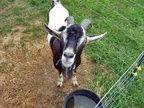Except for the aggressive bucks (and the occasional doe), goats are naturally good-natured than people would credit them for. Caring for goats as pets sounds fun enough. It also means considerable work in terms of raising them.
The fun part stays. The work of feeding and raising them are all paid for almost daily by their affectionate and occasionally funny nature.
Adopting
The first thing to do when deciding to adopt a goat is to check if livestock is permitted in your community. Many suburban cities and towns do not allow this, even as pets.
Some places require special permits. Do the necessary paper preparations before getting your animal.
Behavior
Goats can be affectionate and can become intelligent pets. Knowing the basic facts about goats – their behavior, requirements in housing and food, where to buy them, etc. – can help a prospective goat owner if the idea of keeping the animal as pet is sound.
Goat enthusiasts should know about the mischievous nature of goat behavior. Particularly worth noting would be their tendency to investigate everything with their mouths. These could include your clothes, your hands, your ornamental plants, and just about everything else they find interesting.
Goats are very gregarious animals. They enjoy the social company of other goats, and even other farm animals. (Of course, dominant bucks may fight among themselves from time to time.)
Goats will test your fences, either intentionally or they just would like to climb or jump onto anything. If your fence can be spread, pushed down, or jumped over – they will escape.
Shelter
Have an escape-proof enclosure erected first before bringing in your goat. This should also be good enough to protect him from outside predators (panthers, coyotes, wolves).
Inside the enclosure would be a shelter to protect your goat from rain, snow and draft. A barn or a large shed would be good for his health.
Ideally, there should be some 20 square feet of shelter per goat, in a 200-square feet area of the secured enclosure.
There should be hay for his bedding, water receptacle, and grass hay (like Timothy or Bermuda) for his food which should be available at all times. In areas where the goat cannot pasture (and also on winter months) goat food (grains) must also be available.
Preparations
Prospective goat owners must be prepared with items like de-wormers and other parasite control products. It is also very important to locate and contact a competent veterinarian (ideally for ruminant animals) for illnesses and injuries.
Livestock vets are needed to educate the new goat owners on such topics as routine care, parasite control, shearing, milking, neutering, hoof trimming, dehorning, etc. There are also annual vaccinations needed for tetanus toxoid and clostridium perfringens type C and D toxoid.
The quality of your prospective pet goat is also very important. They can be purchased from breeders, or adopted from animal shelters, etc. Care should be taken that those that are adopted are disease-free, and relatively healthy.
Depending on the sex, breed, and age, a goat will cost from $100 or up to several hundred more. These are typical for specialty goat varieties. Since they are gregarious and can be lonely, get at least a pair.
Now that you are ready for them as pets, are you ready for the constant goat care?
Selengkapnya...





